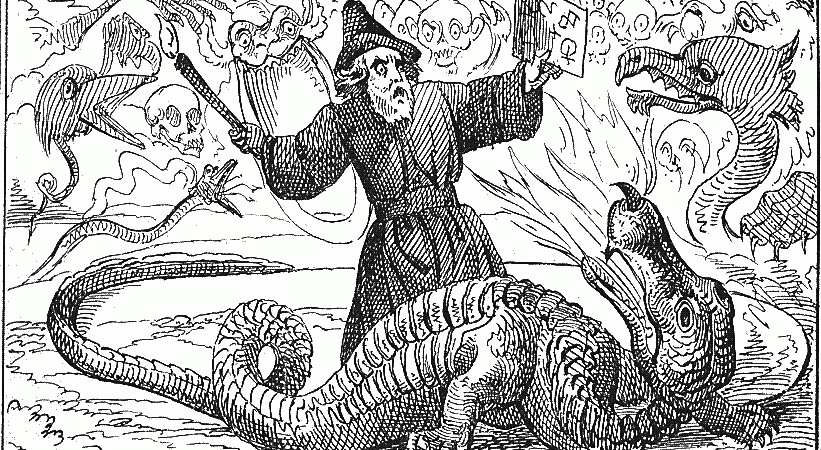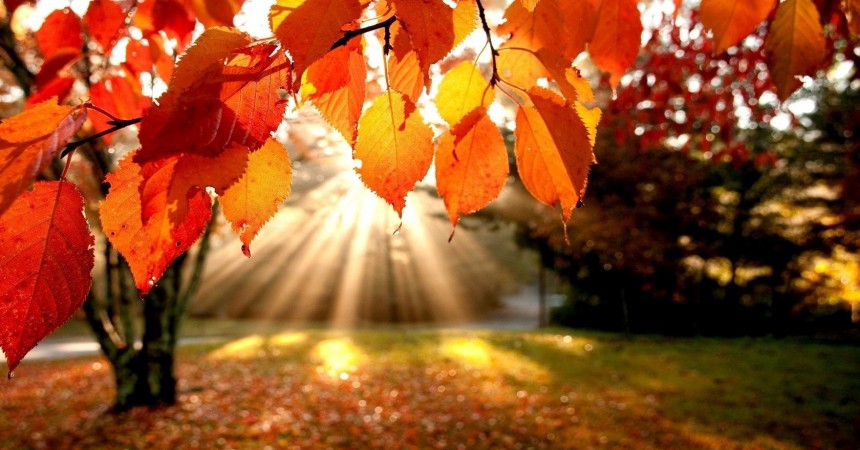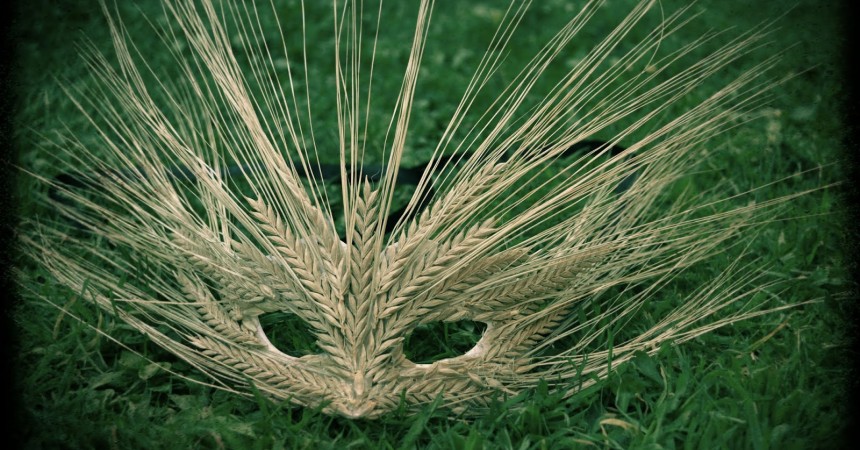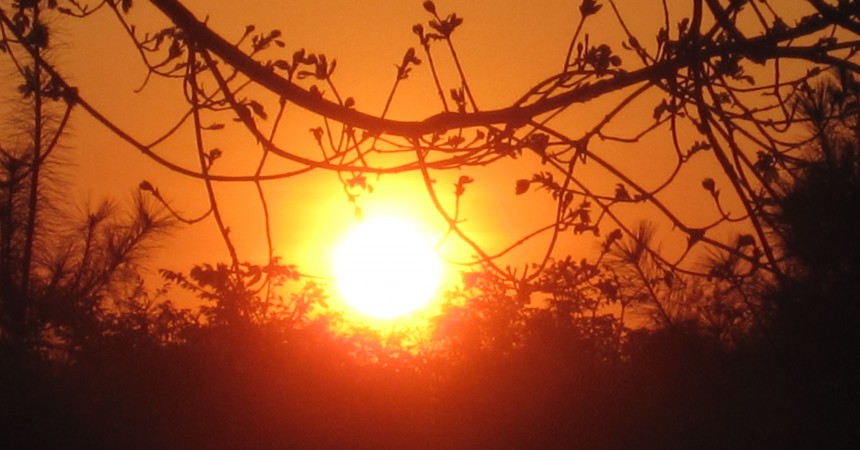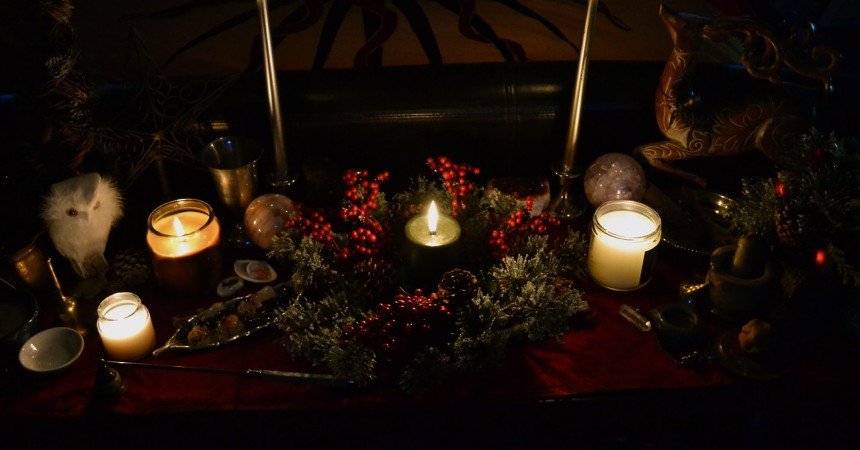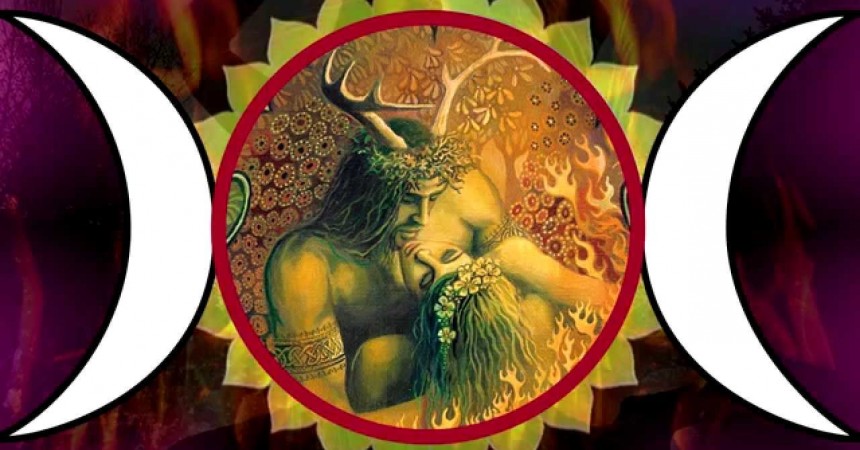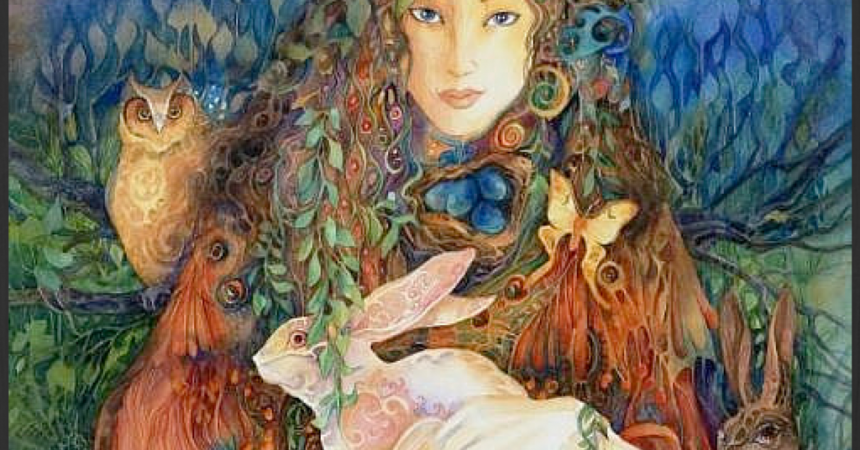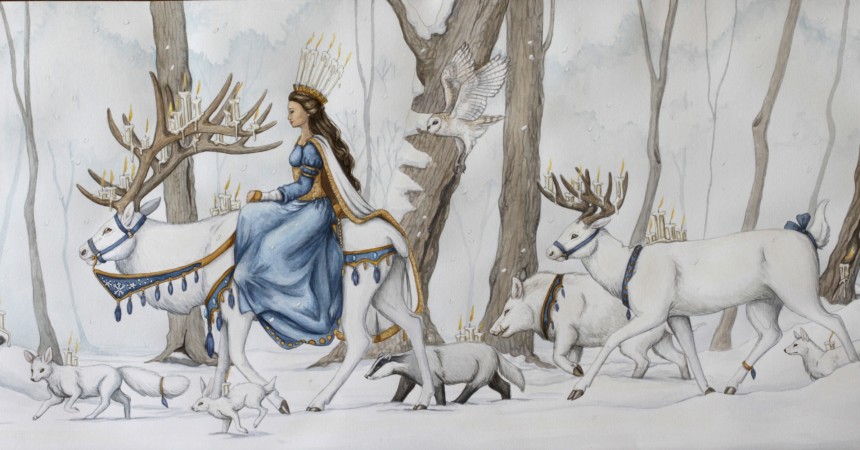About the Key of Solomon
The Key of Solomon is a medieval grimoire, or book of magic, wrongly attributed to Solomon, son of David. Scholars typically identify the Key of Solomon as a 14th- or 15th-century piece of Latin literature.
Most remaining manuscripts date from the 16th to 18th centuries, including translations in several languages, especially Italian. The manuscripts include many pentacles, or necromantic designs, to be used in invocations and spells.
According to the mythology included in the document, King Solomon originally wrote the book for his son Rehoboam and commanded him to hide it in his tomb upon his death. Allegedly, the book was later discovered by a group of Babylonian philosophers while repairing Solomon’s tomb. One of these men received a vision in which a supposed angel commanded him to hide the book from the “unworthy.” This led the philosopher to cast a spell on the book.
The first section of the Key of Solomon includes a variety of chants, spells, and curses to summon or restrain demons and the spirits of the dead. The section also touches on other magic spells dealing with how to become invisible and how to find love. One prayer to cast out a demon reads like this:
“Lord Jesus Christ, the loving son of God, which dost illuminate the hearts of all men in the world, lighten the darkness of my heart, and kindle the fire of thy most holy love in me. Give me true faith, perfect charity, and virtue, whereby I may learn to fear and love thee and keep thy commandments in all things; that when the last day shall come, the angel of god may peaceably take me, and deliver me from the power of the devil, that I may enjoy everlasting rest amidst the company of the holy saints, and sit on thy right. Grant this, thou son of the living God for thy holy name’s sake. Amen.”
This prayer includes an obvious anachronism. The reference to the “Lord Jesus Christ” proves the manuscript was not written during the time of Solomon. The prayer also mixes magic and church teachings, which was common to Italian literature of the Middle Ages.
The second section of the Key of Solomon lists and describes a variety of purifications an exorcist should undergo. Instructions are given on clothing, magical devices, and even animal sacrifices.
In popular culture, the Key of Solomon has received attention due to being featured in Dan Brown’s bestselling 2009 novel The Lost Symbol. While the grimoire’s benefit as a narrative tool is fascinating, its appearance in Brown’s novel does nothing to bolster the Key’s accuracy.
In summary, the Key of Solomon is neither a “key” nor “of Solomon.” It is simply a book of medieval magic that utilizes Judeo-Christian themes. While the book is valuable for historical research, its subject matter is unbiblical. The Key of Solomon is not connected in any way with the biblical character mentioned in its title.
Mabon – Autumn Equinox
Mabon, (pronounced MAY-bun, MAY-bone, MAH-boon, or MAH-bawn) is the Autumn Equinox. The Autumn Equinox divides the day and night equally, and we all take a moment to pay our respects to the impending dark. We also give thanks to the waning sunlight, as we store our harvest of this year’s crops. The Druids call this celebration, Mea’n Fo’mhair, and honor the The Green Man, the God of the Forest, by offering libations to trees. Offerings of ciders, wines, herbs and fertilizer are appropriate at this time. Wiccans celebrate the aging Goddess as she passes from Mother to Crone, and her consort the God as he prepares for death and re-birth.
Various other names for this Lesser Wiccan Sabbat are The Second Harvest Festival, Wine Harvest, Feast of Avalon, Equinozio di Autunno (Strega), Alben Elfed (Caledonii), or Cornucopia. The Teutonic name, Winter Finding, spans a period of time from the Sabbat to Oct. 15th, Winter’s Night, which is the Norse New Year.
At this festival it is appropriate to wear all of your finery and dine and celebrate in a lavish setting. It is the drawing to and of family as we prepare for the winding down of the year at Samhain. It is a time to finish old business as we ready for a period of rest, relaxation, and reflection.
Symbolism of Mabon:
Second Harvest, the Mysteries, Equality and Balance.
Symbols of Mabon:
Wine, gourds, pine cones, acorns, grains, corn, apples, pomegranates, vines such as ivy, dried seeds, and horns of plenty.
Herbs of Maybon:
Acorn, benzoin, ferns, grains, honeysuckle, marigold, milkweed, myrrh, passionflower, rose, sage, solomon’s seal, tobacco, thistle, and vegetables.
Foods of Mabon:
Breads, nuts, apples, pomegranates, and vegetables such as potatoes, carrots, and onions.
Incense of Mabon:
Autumn Blend-benzoin, myrrh, and sage.
Colors of Mabon:
Red, orange, russet, maroon, brown, and gold.
Stones of Mabon:
Sapphire, lapis lazuli, and yellow agates.
Activities of Mabon:
Making wine, gathering dried herbs, plants, seeds and seed pods, walking in the woods, scattering offerings in harvested fields, offering libations to trees, adorning burial sites with leaves, acorns, and pine cones to honor those who have passed over.
Spellworkings of Mabon:
Protection, prosperity, security, and self-confidence. Also those of harmony and balance.
Deities of Mabon:
Goddesses-Modron, Morgan, Epona, Persephone, Pamona and the Muses. Gods-Mabon, Thoth, Thor, Hermes, and The Green Man.
Mabon is considered a time of the Mysteries. It is a time to honor Aging Deities and the Spirit World. Considered a time of balance, it is when we stop and relax and enjoy the fruits of our personal harvests, whether they be from toiling in our gardens, working at our jobs, raising our families, or just coping with the hussle-bussle of everyday life. May your Mabon be memorable, and your hearts and spirits be filled to overflowing!
[reprint courtesy Wicca.com]
Lughnasadh / Lammas
At Lammas (July 31st – August 1st), sometimes called Lughnasadh, it’s time to celebrate the first harvest of the year, and recognize that the hot summer days will soon come to an end. The plants of spring wither and drop seeds to ensure future crops. Grains are ready to be harvested and the fruits are ripe for picking. We can give thanks for the food on our tables.
Lughnasadh means the funeral games of Lugh (pronounced Loo), referring to Lugh, the sun god. However, the funeral is not his own, but the funeral games he hosts in honor of his foster-mother Tailte. For that reason, the traditional Tailtean craft fairs and Tailtean marriages (which last for a year and a day) are also celebrated at this time.
As autumn begins, the Celtic Sun God enters his old age, but is not yet dead. The God symbolically loses some of his strength as the Sun rises farther in the South each day and the nights grow longer.
The Christian religion adopted this theme and called it ‘Lammas ‘, meaning ‘loaf-mass ‘, a time when newly baked loaves of bread are placed on the altar. An alternative date around August 5 (Old Lammas), when the sun reaches 15 degrees Leo, is sometimes employed by Covens.
Traditional Foods:
Apples, Grains, Breads and Berries.
Herbs and Flowers:
All Grains, Grapes, Heather, Blackberries, Sloe, Crab Apples, Pears.
Incense:
Aloes, Rose, Sandalwood.
Sacred Gemstone:
Carnelian.
Special Activities:
As summer passes, many Pagans celebrate this time to remember its warmth and bounty in a celebrated feast shared with family or Coven members. Save and plant the seeds from the fruits consumed during the feast or ritual. If they sprout, grow the plant or tree with love and as a symbol of your connection with the Lord and Lady. Walk through the fields and orchards or spend time along springs, creeks, rivers, ponds and lakes reflecting on the bounty and love of the Lord and Lady.
[reprint courtesy Wicca.com]
Litha – The Summer Solstice
Also known as: Alban Heruin (Druidic)
Although the name Litha is not well attested, it may come from Saxon tradition — the opposite of Yule. On this longest day of the year, light and life are abundant. At mid-summer, the Sun God has reached the moment of his greatest strength. Seated on his greenwood throne, he is also lord of the forests, and his face is seen in church architecture peering from countless foliate masks.
The Christian religion converted this day of Jack-in-the-Green to the Feast of St. John the Baptist, often portraying him in rustic attire, sometimes with horns and cloven feet (like the Greek Demi-God Pan)
Midsummer Night’s Eve is also special for adherents of the Faerie faith. The alternative fixed calendar date of June 25 (Old Litha) is sometimes employed by Covens. The name Beltane is sometimes incorrectly assigned to this holiday by some modern traditions of Wicca, even though Beltane is the Gaelic word for May.
Traditional Foods:
Garden fresh fruits and vegetables are made into a variety of dishes and eaten by Pagan’s who choose to celebrate this day.
Herbs and Flowers:
Mugwort, Vervain, Chamomile, Rose, Honeysuckle, Lily, Oak, Lavender, Ivy, Yarrow, Fern, Elder, Wild Thyme, Daisy, Carnation.
Incense:
Lemon, Myrrh, Pine, Rose, Wisteria.
Woods Burned:
Oak
Sacred Gemstone:
Emerald
Special Activities:
An Ideal time to reaffirm your vows to the Lord and Lady or your dedication to following the old traditions.
[reprint courtesy Wicca.com]
YULE – The Winter Solstice
The date varies from December 20 to December 23 depending on the year in the Gregorian calendar. Yule is also known as the winter solstice in the northern hemisphere and the summer solstice in the southern hemisphere due to the seasonal differences.
Yule, (pronounced EWE-elle) is when the dark half of the year relinquishes to the light half. Starting the next morning at sunrise, the sun climbs just a little higher and stays a little longer in the sky each day. Known as Solstice Night, or the longest night of the year, the sun’s “rebirth” was celebrated with much joy. On this night, our ancestors celebrated the rebirth of the Oak King, the Sun King, the Giver of Life that warmed the frozen Earth. From this day forward, the days would become longer.
Bonfires were lit in the fields, and crops and trees were “wassailed” with toasts of spiced cider. Children were escorted from house to house with gifts of clove spiked apples and oranges which were laid in baskets of evergreen boughs and wheat stalks dusted with flour. The apples and oranges represented the sun. The boughs were symbolic of immortality (evergreens were sacred to the Celts because they did not “die” thereby representing the eternal aspect of the Divine). The wheat stalks portrayed the harvest, and the flour was accomplishment of triumph, light, and life. Holly and ivy not only decorated the outside, but also the inside of homes, in hopes Nature Sprites would come and join the celebration. A sprig of Holly was kept near the door all year long as a constant invitation for good fortune to visit tthe residents. Mistletoe was also hung as decoration. It represented the seed of the Divine, and at Midwinter, the Druids would travel deep into the forest to harvest it.
The ceremonial Yule log was the highlight of the Solstice festival. In accordance to tradition, the log must either have been harvested from the householder’s land, or given as a gift… it must never have been bought. Once dragged into the house and placed in the fireplace it was decorated in seasonal greenery, doused with cider or ale, and dusted with flour before set ablaze by a piece of last years log, (held onto for just this purpose). The log would burn throughout the night, then smolder for 12 days after before being ceremonially put out. Ash is the traditional wood of the Yule log. It is the sacred world tree of the Teutons, known as Yggdrasil. An herb of the Sun, Ash brings light into the hearth at the Solstice.
A different type of Yule log, and perhaps one more suitable for modern practitioners would be the type that is used as a base to hold three candles. Find a smaller branch of oak or pine, and flatten one side so it sets upright. Drill three holes in the top side to hold red, green, and white (season), green, gold, and black (the Sun God), or white, red, and black (the Great Goddess). Continue to decorate with greenery, red and gold bows, rosebuds, cloves, and dust with flour.
Many customs created around Yule are identified with Christmas today. If you decorate your home with a Yule tree, holly or candles, you are following some of these old traditions. The Yule log, (usually made from a piece of wood saved from the previous year) is burned in the fire to symbolize the Newborn Sun/Son.
Deities of Yule: All Newborn Gods, Sun Gods, Mother Goddesses, and Triple Goddesses. The best known would be the Dagda, and Brighid, the daughter of the Dagda. Brighid taught the smiths the arts of fire tending and the secrets of metal work. Brighid’s flame, like the flame of the new light, pierces the darkness of the spirit and mind, while the Dagda’s cauldron assures that Nature will always provide for all the children.
Symbolism of Yule:
Rebirth of the Sun, The longest night of the year, The Winter Solstice, Introspect, Planning for the Future.
Symbols of Yule:
Yule log, or small Yule log with 3 candles, evergreen boughs or wreaths, holly, mistletoe hung in doorways, gold pillar candles, baskets of clove studded fruit, a simmering pot of wassail, poinsettias, christmas cactus.
Herbs of Yule:
Bayberry, blessed thistle, evergreen, frankincense holly, laurel, mistletoe, oak, pine, sage, yellow cedar.
Foods of Yule:
Cookies and caraway cakes soaked in cider, fruits, nuts, pork dishes, turkey, eggnog, ginger tea, spiced cider, wassail, or lamb’s wool (ale, sugar, nutmeg, roasted apples).
Incense of Yule:
Pine, cedar, bayberry, cinnamon.
Colors of Yule:
Red, green, gold, white, silver, yellow, orange.
Stones of Yule:
Rubies, bloodstones, garnets, emeralds, diamonds.
Activities of Yule:
Caroling, wassailing the trees, burning the Yule log, decorating the Yule tree, exchanging of presents, kissing under the mistletoe, honoring Kriss Kringle the Germanic Pagan God of Yule
Spellworkings of Yule:
Peace, harmony, love, and increased happiness.
Deities of Yule:
Goddesses-Brighid, Isis, Demeter, Gaea, Diana, The Great Mother. Gods-Apollo, Ra, Odin, Lugh, The Oak King, The Horned One, The Green Man, The Divine Child, Mabon.
[reprint courtesy Wicca.com]
Beltane
Also known as Roodmas or May Day
Many Wiccans and Pagans celebrate Beltane. It is one of eight solar Sabbats. This holiday incorporates traditions from the Gaelic Bealtaine, such as the bonfire, but it bears more relation to the Germanic May Day festival, both in its significance (focusing on fertility) and its rituals (such as May pole dancing). Some traditions celebrate this holiday on May 1 or May day, whiles others begin their celebration the eve before or April 30th.
Beltane has long been celebrated with feasts and rituals. The name means fire of Bel; Belinos being one name for the Sun God, whose coronation feast we now celebrate. As summer begins, weather becomes warmer, and the plant world blossoms, an exuberant mood prevails. In old Celtic traditions it was a time of unabashed sexuality and promiscuity where marriages of a year and a day could be undertaken but it is rarely observed in that manner in modern times.
In the old Celtic times, young people would spend the entire night in the woods “A-Maying,” and then dance around the phallic Maypole the next morning. Older married couples were allowed to remove their wedding rings (and the restrictions they imply) for this one night. May morning is a magickal time for wild water (dew, flowing streams, and springs) which is collected and used to bathe in for beauty, or to drink for health.
The Christian religion had only a poor substitute for the life-affirming Maypole — namely, the death-affirming cross. Hence, in the Christian calendar, this was celebrated as ‘Roodmas’. In Germany, it was the feast of Saint Walpurga, or ‘Walpurgisnacht’. An alternative date around May 5 (Old Beltane), when the sun reaches 15 degrees Taurus, is sometimes employed by Covens. (Both ‘Lady Day’ and ‘Ostara’ are names incorrectly assigned to this holiday by some modern traditions of Wicca.)
The May pole was a focal point of the old English village rituals. Many people would rise at the first light of dawn to go outdoors and gather flowers and branches to decorate their homes. Women traditionally would braid flowers into their hair. Men and women alike would decorate their bodies. Beltane marks the return of vitality, of passion. Ancient Pagan traditions say that Beltane marks the emergence of the young God into manhood. Stirred by the energies at work in nature, he desires the Goddess. They fall in love, lie among the grasses and blossoms, and unite. The Goddess becomes pregnant of the God. To celebrate, a wedding feast, for the God and Goddess must be prepared. Let Them guide you!
Breads and cereals are popular. Try oatmeal cakes or cookies sweetened with a dab of honey. Dairy foods are again appropriate…just make a lovely wedding feast and you are sure to enjoy yourself! An early morning walk through a local park or forest could be fun for everyone. Gather up some plants or flowers to display in your home. Mom and daughter could braid their hair, and weave in a few tender blossoms.
[reprint courtesy Wicca.com]
Ostara – Spring, or The Vernal Equinox
Also known as: Lady Day or Alban Eiler (Druidic)
As Spring reaches its midpoint, night and day stand in perfect balance, with light on the increase. The young Sun God now celebrates a hierogamy (sacred marriage) with the young Maiden Goddess, who conceives. In nine months, she will again become the Great Mother. It is a time of great fertility, new growth, and newborn animals.
The next full moon (a time of increased births) is called the Ostara and is sacred to Eostre the Saxon Lunar Goddess of fertility (from whence we get the word estrogen, whose two symbols were the egg and the rabbit.
The Christian religion adopted these emblems for Easter which is celebrated on the first Sunday after the first full moon following the vernal equinox. The theme of the conception of the Goddess was adapted as the Feast of the Annunciation, occurring on the alternative fixed calendar date of March 25 Old Lady Day, the earlier date of the equinox. Lady Day may also refer to other goddesses (such as Venus and Aphrodite), many of whom have festivals celebrated at this time.
Traditional Foods:
Leafy green vegetables, Dairy foods, Nuts such as Pumpkin, Sunflower and Pine. Flower Dishes and Sprouts.
Herbs and Flowers:
Daffodil, Jonquils, Woodruff, Violet, Gorse, Olive, Peony, Iris, Narcissus and all spring flowers.
Incense:
Jasmine, Rose, Strawberry, Floral of any type.
Sacred Gemstone:
Jasper
Special Activities:
Planting seeds or starting a Magickal Herb Garden. Taking a long walk in nature with no intent other than reflecting on the Magick of nature and our Great Mother and her bounty.
[reprint courtesy Wicca.com]
Imbolc
Also known as: Oimelc, Candlemas, St Brigit’s Day.
As with all Old Tradition observances, this holiday is usually celebrated beginning at sundown on February 1 and continuing through the day of February 2. Imbolc means in the belly of the Mother because that is where seeds are beginning to stir as it is Spring.
Another name for this holiday is Oimelc, meaning milk of ewes since it is also the traditional lambing season in the old world. Herd animals have either given birth to the first offspring of the year or their wombs are swollen and the milk of life is flowing into their teats and udders. It is the time of Blessing of the seeds and consecration of agricultural tools. It marks the center point of the dark half of the year.
This holiday is especially sacred to the Celtic Fire Goddess, Brigit, patron of smithcraft, healing, midwifery, and poetry. It is the festival of the Maiden, for from this day to March 21st, it is her season to prepare for growth and renewal. The Maiden is honored, as the Bride, on this Sabbat. Straw Brideo’gas (corn dollies) are created from oat or wheat straw and placed in baskets with white flower bedding. Young girls then carry the Brideo’gas door to door, and gifts are bestowed upon the image from each household. Afterwards at the traditional feast, the older women make special acorn wands for the dollies to hold, and in the morning the ashes in the hearth are examined to see if the magic wands left marks as a good omen. Brighid’s Crosses are fashioned from wheat stalks and exchanged as symbols of protection and prosperity in the coming year. Home hearth fires are put out and re-lit, and a besom is place by the front door to symbolize sweeping out the old and welcoming the new. Candles are lit and placed in each room of the house to honor the re-birth of the Sun.
A Covens High Priestess may wear a crown of lights (candles) to symbolize the return of the Goddess to her Maiden aspect, just as the Sun God has reached puberty. Brighid’s snake emerges from the womb of the Earth Mother to test the weather, (the origin of Ground Hog Day), and in many places the first Crocus flowers began to spring forth from the frozen earth.
The Christian religion adopted a number of these themes, as follows: February 1 became St. Brigit’s Day, and February 2 became Candlemas, the day to make and bless candles for the liturgical year. The ‘Feast of the Purification of the Blessed Virgin Mary ‘ adapts the Maiden Goddess theme. The alternative date of February 14 Old Candlemas, Christianized as Valentine’s Day is employed by some Covens.
Symbolism of Imbolc:
Purity, Growth and Re-Newal, The Re-Union of the Goddess and the God, Fertility, and dispensing of the old and making way for the new.
Symbols of Imbolc:
Brideo’gas, Besoms, White Flowers, Candle Wheels, Brighid’s Crosses, Priapic Wands (acorn-tipped), and Ploughs.
Herbs of Imbolc:
Angelica, Basil, Bay Laurel, Blackberry, Celandine, Coltsfoot, Heather, Iris, Myrrh, Tansy, Violets, and all white or yellow flowers.
Foods of Imbolc:
Pumpkin seeds, Sunflower seeds, Poppyseed Cakes, muffins, scones, and breads, all dairy products, Peppers, Onions, Garlic, Raisins, Spiced Wines and Herbal Teas.
Incense of Imbolc:
Basil, Bay, Wisteria, Cinnamon, Violet, Vanilla, Myrrh.
Colors of Imbolc:
White, Pink, Red, Yellow, lt. Green, Brown.
Stones of Imbolc:
Amethyst, Bloodstone, Garnet, Ruby, Onyx, Turquoise.
Activities of Imbolc:
Candle Lighting (light Candles or lamps in each room of the house right after sunset for a few minutes to honor the Sun’s rebirth), Stone Gatherings, Snow Hiking and Searching for Signs of Spring, Making of Brideo’gas and Bride’s Beds, Making Priapic Wands, Decorating Ploughs, Feasting, and Bon Fires maybe lit.
[reprint courtesy Wicca.com]
